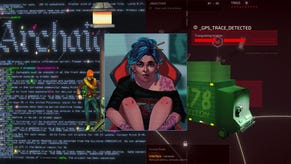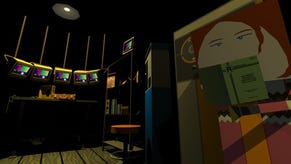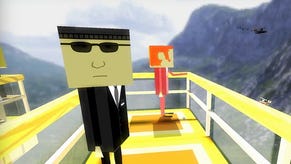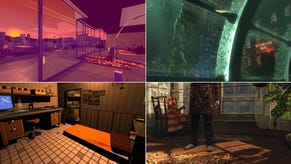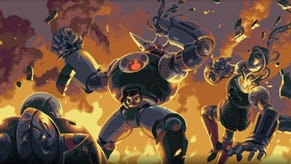Hacking Done Right: Quadrilateral Cowboy
Neuromance At First Sight
I think I have every right to consider myself a master hacker. I mean, videogames told me so. Let's look at my qualifications: I can arrange electric pipe mazes, solve obnoxious word matching puzzles, and make my way through colorful, LED-hued node spiderwebs. That's right, governments of the world. You know you want me to lock down your security systems for you. Nice and tight. Mmm-hmm. OK, that got weird. But anyway, let's be honest here: hacking minigames tend to have zero basis in reality, and often end up feeling annoying, awkward, and out-of-place. In Blendo's (they of Gravity Bone, Thirty Flights Of Loving, and Atom Zombie Smasher fame) Quadrilateral Cowboy, however, hacking is the entire game. So, how's it work? Incredibly well, if the demo I played during PAX is any indication.
"I cannot open this fucking grate." If my life were ever adapted into a techno-magical cyberpunk tale for the ages, that'd be the first line. Or at least, that's what I thought when I first started playing Blendo's latest first-person not-shooter, Quadrilateral Cowboy. You see, I had to break into a building via its ventilation system, but I had no convenient Deus Ex logic on my side. So I tossed down my "deck" - aka a laptop - and it proceeded to sit smugly on the ground, mocking me. "Hey everyone, look at the code-illiterate lamebrain," it seemed to shout. "He thinks he's people! That's so cute." Its screen yielded a command prompt with a dazzling array of options: directories, programs whose functions weren't readily apparent, and heaps more. Words. So many words. Heck, even typing in "help" just spat out more thick gobs of information for my gnarled brain to chew on.
But then I started looking around. As it turned out, a warning label on the grate - what would've been a throwaway low-res texture in any other game - was key. Partially singed for reasons unknown (an incredibly small, non-spreading fire seems likely), only portions of it were legible. I could make out, however, that I needed to boot up a program called Telnet and type in a command involving the words "grate2" and "open." So I went with "grate2.open," and it worked! But also, an alarm went off. Perplexed, I realized that I probably should've also paid attention to another label, which - in fittingly teensy-tiny caution text - noted that the facility would sound an intruder alert if anything stayed open for more than three seconds. So then, "grate2.open(3)" it was. I opened a grate! Gaze upon my mighty cybermind and weep cold, digitized tears!
Here's the thing, though: I really did feel like a total badass for performing an incredibly mundane and basic task. I overheard creator Brendon Chung use the phrase "Guitar Hero of coding," and it honestly fits. Obviously, nothing's that simple in real life, but the idea is to add a dash of pseudo-reality to the magical Hollywood hacker fantasy. And it works. It really, really works. There's just something inherently cool about being in total control of an environment with a few (once you've learned them) simple keystrokes.
So I continued onward, only to find myself cornered by two cameras. If I tried to advance, they'd spot me in a heartbeat. Once again, I was at a loss. But then another environmental clue - this time, a wall poster (this is a tutorial we're talking about, after all) - pointed the way. In short, it noted that I could enter multiple commands at once and pause the timer in between each. In this case, I needed to deal with two cameras and one door. Three seconds a piece. So, after a couple slip-ups and the discovery of a glitch involving a chair that, er, essentially allowed me to fly, I went with "camera1.off(3);wait(2);camera2.off(3);wait(2);door2.open(3)."
Then I hit enter, and it was like watching the Red Sea part for me. Just as I moved into the range of each camera, off it went. And the door stepped aside as though it were a polite hotel bellhop. I'd orchestrated the whole thing perfectly, and - once again - I felt like some kind of techno-demigod.
Another level, meanwhile, put me in control of a far more complex task. This time, in addition to my deck, my inventory also contained a fully mobile hacking drone known as a Weevil. It looked like a soup can with tiny peg legs and was cute as the dickens. Also, it leaped like a cybernetically enhanced headcrab that could totally play professional basketball if, again, it wasn't part-soup-can. Eventually, I came to a non-hackable door. It did, however, have a mail slot, so I said a brief goodbye to my little friend. Then things got complicated.
A developer ended up walking me through the process of setting up my Weevil Command Center, which involved laying out both my deck and a small monitor screen so I could glance over and see through its eyes, then entering a few lines of code to connect all of those things together. Controlling the Weevil, meanwhile, required numerical instructions, and the terminal I was trying to hack was all the way on the other side of the room. Naturally, the process could've gone a bit smoother. Still though, I was surprised at how quickly I was able to pick it up. The Weevil had its own separate program, so commands simply involved distance - "move(100)" for 100 centimeters, etc. Turning, meanwhile, was based in degrees, with "turn(90)" and "turn(-90)" corresponding to right and left, respectively.
At that point, only one problem remained: the terminal was - by meticulous number-powered Weevil standards - like, really high up and stuff. So I typed in a single command: "jump". Sure enough, my avatar's tiny avatar soared. It ended up landing just behind the terminal on the desk, so - in theory - I only needed to enter a couple lines of code to pilot it into place. Unfortunately, this was an early build, so the Weevil kept getting stuck in the wall. Worse, it then also managed to get stuck underground, at which point I decided to call it quits for that session.
So obviously, I do have some concerns. Chung's planning to let this one bake until sometime in 2013, but we're talking about a developer with something of a reputation for crashy games. It would, of course, be comically ironic if a game that glorified the sheer power of good code turned out to be badly coded - not to mention rather disappointing. Also, puzzle complexity's another potential sore spot. By and large, the bits I played proved to be pretty decent at teaching fairly complex concepts, but - based on my initial dig through the deck's options - the range of possibilities here is positively colossal. On the flipside of that equation, however, Chung hasn't decided whether or not he'll implement NPCs and other impediments to success yet, so I could also see the formula getting repetitive or lacking the high stakes to remain exciting for long periods of time.
My 40-some-odd-minute session with Quadrilateral Cowboy did, however, leave me absolutely starved for more, so that's a very good sign. And though Cowboy takes place in the same charmingly square-headed world and continuity as Gravity Bone and Thirty Flights, it's set to be far lengthier than both. So I'm feeling pretty good about this one. Maybe even grate.
Check back tomorrow for an interview with Blendo's Brendon Chung about Quadrilateral Cowboy, 30 Flights Of Loving, using crazy experimental story ideas in games that are more, well, game-y, and heaps more!



